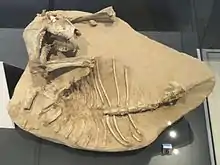Merychyus
Merychyus is an extinct genus of oreodont of the family Merycoidodontidae, endemic to North America. It lived during the Miocene, 20.4—10.3 mya, existing for approximately 10 million years .[1] Fossils are widespread through the central and western United States.
| Merychyus | |
|---|---|
 | |
| M. elegans fossil, Royal Ontario Museum | |
| Scientific classification | |
| Kingdom: | Animalia |
| Phylum: | Chordata |
| Class: | Mammalia |
| Order: | Artiodactyla |
| Family: | †Merycoidodontidae |
| Genus: | †Merychyus Leidy 1858 |
| Type species | |
| Merychyus elegans Leidy 1858 | |
| Species | |
| |
| Synonyms | |
| |
Merychyus was a herbivore with a short face, tusk-like canine teeth, heavy body, long tail, short feet, and four-toed hooves.
Fossil distribution
Fossils of the genus have been found in:[1]
- Arikareean
- Chalk Canyon Formation, Arizona
- Diligencia, Sespe & Tick Canyon Formations, California
- Arikaree Formation, North Dakota
- John Day Formation, Oregon
- Delaho Formation, Texas
- Colter, Harrison & Marsland Formations, Wyoming
- Harrisonian
- Hector Formation, California
- Harrison & Marsland & Wildcat Hills Beds Formations, Nebraska
- Rosebud Formation, South Dakota
- Delaho Formation, Texas
- Harrison & Marsland Formations, Wyoming
- Other Miocene
- Cypress Hills Formation, Hemingfordian Saskatchewan, Canada
- Suchilquitongo Formation, Mexico
- Barstow, Bopesta, Branch Canyon, Hector, Kramer Beds & Vaqueros Formations, California
- Browns Park & Pawnee Creek Formations, Colorado
- Railroad Canyon Beds Formation, Idaho
- Fleming Formation, Louisiana
- Runningwater, Sheep Creek, Olcott, Loop Fork, Box Butte, Valentine & Ash Hollow Formations, Nebraska
- Truckee & Monarch Mill Formations, Nevada
- Tesuque, Zia Sand & Abiquiu Formations, New Mexico
- Laverne Formation, Oklahoma
- Juntura & John Day Formations, Oregon
- Arikaree & Batesland Formations, South Dakota
- Goliad Formation, Texas
- Marsland, Colter, North Park, Arikaree & Carpenter Ranch Formations, Wyoming
References
- Merychyus at Fossilworks.org
Bibliography
- J. Leidy. 1858. Notice of Remains of Extinct Vertebrata, from the Valley of the Niobrara River, Collected during the Exploring Expedition of 1857, in Nebraska, under the Command of Lieut. G. K. Warren, U. S. Top. Eng., by Dr. F. V. Hayden, Geologist to the Expedition. Proceedings of the Academy of Natural Sciences of Philadelphia 10:15-89
This article is issued from Wikipedia. The text is licensed under Creative Commons - Attribution - Sharealike. Additional terms may apply for the media files.